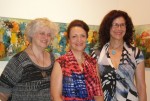From left to right, Echoes artists Sidi Schaffer, Sorour Abdollahi and Devora. (photo by Olga Livshin)
The term “artistic brotherhood” was coined in the 19th century. Among the most famous of such brotherhoods were the Pre-Raphaelites in England and the Canadian Group of Seven, and every brotherhood was comprised of artists united by similar artistic principles. Recently, such an artistic union appeared in Vancouver, but it is a sisterhood, compromising Sidi Schaffer, Sorour Abdollahi and Devora. They call themselves Echoes.
The trio’s first combined show was at the Sidney and Gertrude Zack Gallery in 2008. It was a success, and they have repeated the experience twice over the years. Earlier this month, they opened their fourth show together. Called Three Echoes: Harmony through Art, it opened July 8 at Britannia Art Gallery.
Even though their initial collaboration started by chance, the artists have stayed together as a cohesive group because of their common outlook on life and art. Despite differences in their ethnic and cultural origins, their humanity and the ties of friendship transcend age and space, traditions and societies.
Schaffer was born in Romania, a child survivor of the Holocaust. She received her first artistic education in Israel, but Canada allowed her to thrive as an artist. At various stages of her creative development, she has tried different expressive formats, and now she blends them all. Her paintings have figures in them but they tend towards the abstract, hinting at multiple meanings and deep, complex emotions.
Inspired by nature and by her beloved Israel, Schaffer uses mixed media – painting, collage, glue, melted wax and a number of others – in her imagery. Her art minimizes the gap between abstract and figurative, between dreams and life. Playful and nostalgic, her paintings infuse the show with the elemental simplicity of her early childhood.
“We keep the name Echoes,” she said, “because our art is echoing our lives and our pasts, our different backgrounds, and our common present. We regard art in a similar way, although we’re inspired by different matters. Devora draws her inspiration from inside. I find inspiration in nature, while Sorour seeks hers in the rich cultural heritage of Persia.”
Like the other two Echoes, Abdollahi is an immigrant. She came to Canada from Iran in 2000. But, unlike the other two, she is not Jewish. Ancient Persian culture permeates her paintings with generational memories. “My paintings are a bridge between the old Persia and the young Canada, a negotiation between history and modernity,” she said.
Abdollahi’s paintings are as much a declaration of her inner manifesto as they are a mystery for viewers to explore, often on the visceral level. “Many old buildings in Iran have mysteries in them. A half-hidden corner. An invisible door. Architecture has layers, some showing, others not, through the centuries of history. I like to reflect that in my paintings. I say with my art: look, there is something here, but I don’t say everything. I let people guess and imagine.”
She explained that both her Iranian roots and her Canadian experience have influenced her works enormously, creating a conversation between the old and the new, juxtaposing West and East. “Ancient ruins play a pivotal role in my paintings,” she said. “They enable me to express the conflict between different cultures and societies…. My paintings capture the process of change and its effects through the use of layers and textures.”
Although her works’ essence leans towards the abstract, playing with bright colors and enigmatic shapes, there is always a core of reality in every painting, that hidden door through which we are invited to glimpse the artist’s private landscape.
“Our art connects us,” said Abdollahi of Echoes. “We complete each other as artists. Each one of us, like everyone else, in every city and country, is reaching for peace, for the world without borders between people and nations. We are trying to achieve such a world through our art.”
Devora is the one who brought Echoes together.
She met Schaffer during the Gesher Project, which the Vancouver Holocaust Education Centre website describes as a “project undertaken by Vancouver Holocaust survivors, child survivors and adult children of survivors. They met over a six-month period in 1998 to examine the impact of the Holocaust on their lives. They explored these experiences through painting, writing and discussion assisted by facilitators…. The project culminated with the mounting of the Gesher [Bridge] exhibit.”
Devora attended an art class with Abdollahi. Later, she introduced her two new friends to each other, and Echoes was born as an informal collective.
A transplanted American, Devora is a firm believer in dialogue between cultures. Her paintings are fully abstract, with colors flowing around each other, energy spiking, and whimsical forms unfolding into new revelations.
“My art reflects my personal search for clarity,” she said. “I am fascinated by dreams and fantasy and the interplay with the concrete and tangible. I am interested in what is hidden, how it informs what is revealed, and the tension and symbiotic relationship between the two.”
In her introductory remarks during the show’s opening, Devora talked about the closeness of the three Echoes members, despite their seemingly contrasting cultural foundations.
“When we go to an art show of some other artist, we always end up in front of the same painting, and our reactions are similar,” she said. “We have the same artistic taste. Our mutual experience as immigrants in Canada forms one of the many bridges that connect us. Our artistic ideas enrich each other, allow us a deeper understanding and lead to transformative commonalities…. Our esthetic communication is a model of a peaceful world, a microcosm of a greater ideal of partnership, a proof that it can be done.”
Three Echoes: Harmony through Art is on display until July 31.
Olga Livshin is a Vancouver freelance writer. She can be reached at [email protected].

